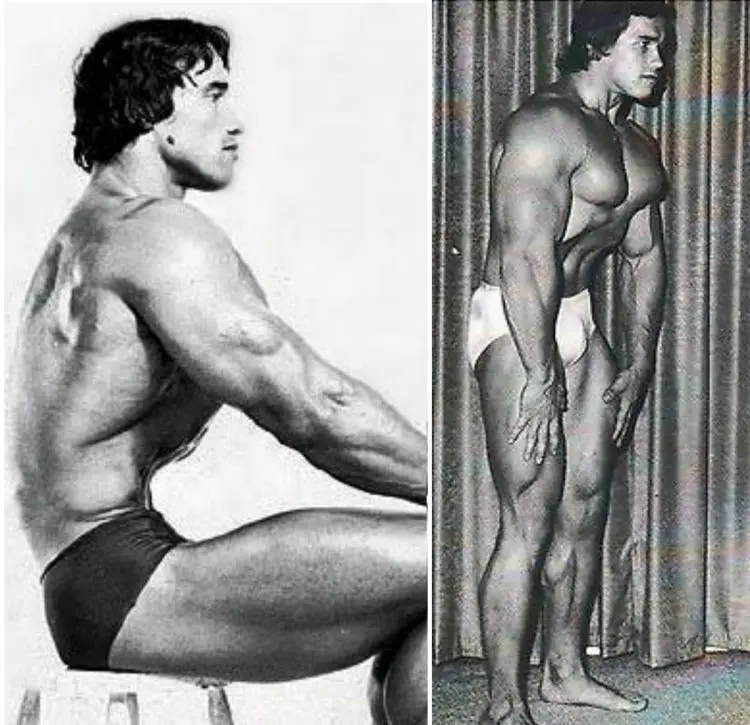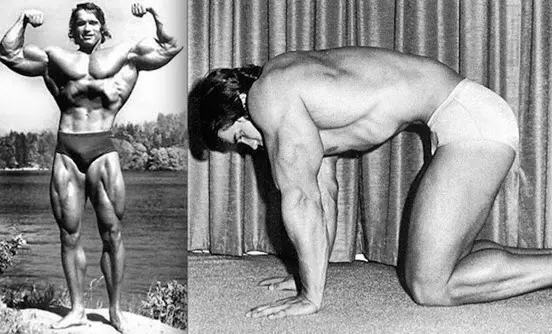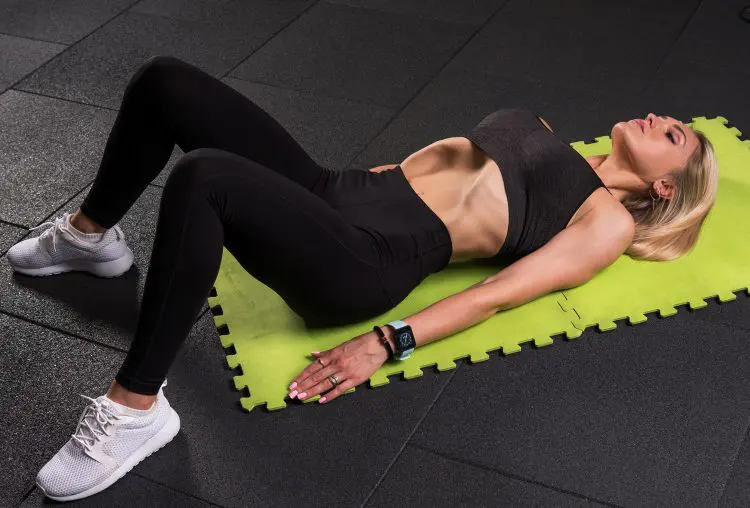Most modern bodybuilders are mass monsters. They look like they are from a different planet – Planet Fitness perhaps?! However, those colossal biceps, ultra-wide lats, and mountainous traps are often accompanied by something much less attractive – a large, swollen gut.
We’re not talking off-season bodybuilders who are carrying more body fat than usual but lifters with single-digit body fat who still have a bubble belly.

In contrast, golden-era lifters often had very small waists. This gave them a much more aesthetically pleasing V-shape. Many of these physique stars made a point of accentuating their slimline waists by pulling their abs in. This made their waists look even smaller!

We’re not saying ALL modern bodybuilders have large waists – there are exceptions – but many of the current crop of top competitors have big bellies, which can detract from their overall appearance.
These big guts may or may not be due to growth hormone use; that’s a discussion for another day. However, it’s clear to see that bodybuilder’s midsections have changed dramatically over the last few decades.
Level Up Your Fitness: Join our 💪 strong community in Fitness Volt Newsletter. Get daily inspiration, expert-backed workouts, nutrition tips, the latest in strength sports, and the support you need to reach your goals. Subscribe for free!
The good news is that you may be able to reduce your waist size while strengthening your abs. How? With the old-school stomach vacuum exercise!
Stomach Vacuum Anatomy
The stomach vacuum exercise is a very simple way to train your deep core muscles, specifically your transverse abdominis, or TVA for short. You use your TVA to brace your midsection and increase intra-abdominal pressure. Along with your other core muscles, it acts as a natural weightlifting belt to support your lumbar spine.

However, as well as contracting it isometrically, as you do when you brace, you can also draw your TVA in, which is what the vacuum exercise is all about. This is often called abdominal hollowing.
When you pull your TVA in, you activate it in isolation, whereas bracing involves your entire midsection, where all the core muscles work together (1).
This means that bracing is better than hollowing for increasing intra-abdominal pressure, which is important for protecting your spine during things like squats and deadlifts. That said, hollowing is the most effective way to target your TVA in isolation.
A stronger TVA will allow you to brace harder and may also help give you a flatter abdominal profile. In short, done regularly and consistently, the stomach vacuum exercise could give you a smaller waist.
Of course, stomach vacuuming won’t make your waist much smaller if you are carrying a whole lot of belly fat. The only way you get rid of that is through diet and exercise or liposuction if you want to go down the surgical route.
Best of all, the vacuum exercise is really easy to do, requires no special equipment, and you can do it almost anywhere and anytime.
How to Do the Stomach Vacuum Exercise
The basic stomach vacuum exercise is very straightforward. In fact, you could probably do a few reps now as you read this article…

- Seated or standing in good posture, exhale fully.
- Pull your stomach in, imagining you are trying to touch your spine with your belly button.
- Try to breathe normally as you keep your abdomen pulled in.
- Relax your abs, exhale, and repeat.
- Increase the length of the hold as you get stronger. 5-10 seconds is a good place to start. Advanced exercisers may work up to 30, 45, or even 60 seconds.
Take care NOT to hold your breath during this exercise, as doing so could lead to dizziness and may increase your blood pressure. Increased BP is not an issue if your readings are normal but could be problematic if you have hypertension (clinically elevated blood pressure).
Stomach Vacuum Variations
Once you can do stomach vacuums seated or standing, there are a few other variations you can use to challenge your transverse abdominus. Use these exercises to stop your TVA workouts from becoming repetitive and boring.
1. Kneeling Stomach Vacuum
Level Up Your Fitness: Join our 💪 strong community in Fitness Volt Newsletter. Get daily inspiration, expert-backed workouts, nutrition tips, the latest in strength sports, and the support you need to reach your goals. Subscribe for free!
With this variation, you pull your stomach in against gravity and the weight of your internal organs. This makes stomach vacuuming slightly harder.
- Kneel on all fours with your shoulders directly over your hands and your hips over your knees. Your spine and neck should remain neutral.
- Exhale and pull your stomach in.
- Breathe normally and hold your abs in for the desired duration.
- Relax your abs, exhale, and repeat.
2. Prone Stomach Vacuum
This variation provides useful feedback as you’ll be able to feel your stomach lifting away from the floor. As with variation #1, you also have to overcome gravity and the weight of your internal organs, making this slightly more challenging than the seated/standing variation.
- Lie on your front with your forehead resting on your arms. Your legs should be straight.
- Exhale and pull your stomach in, lifting your belly button off the floor.
- Breathe normally and hold your abs in for the desired duration.
- Relax your abs, exhale, and repeat.
3. Supine Stomach Vacuum
You do this exercise lying on your back. This makes pulling your stomach in easier because you’re working with instead of against gravity. This is a good option if you find the seated or standing variations too challenging or just want a less demanding TVA workout.
- Lie comfortably on your back with your legs straight, arms by your sides. Or, if you prefer, bend your legs and place your feet flat.
- Exhale and pull your stomach in, trying to make your midsection as thin as possible.
- Breathe normally and hold your abs in for the desired duration.
- Relax your abs, exhale, and repeat.
4. The String Technique
This variation teaches you to keep your stomach pulled in for longer. It provides a physical reminder to activate your TVA and pull your belly in. If you want to train yourself to keep your stomach pulled in, this exercise will help.
- Seated or standing, exhale and pull your stomach part-way in.
- Tie a piece of string around your stomach, level with your belly button. Use a bow so you can undo the string easily.
- Breathe normally while keeping your stomach pulled in.
- Pull your abs in whenever you feel them start to relax and press against the string.
- Continue for 5-10 minutes, gradually increasing duration over several weeks. Build up to wearing the string for several hours at a time.
5. Vacuum abs crunches
Doing a vacuum while you do crunches will increase total core muscle activation, leading to more effective abs workouts. You can also try vacuuming during other abs exercises, such as flutter kicks, planks, and hanging knee raises.
- Lie on the floor with your legs bent and feet flat. Place your hands on your temples, cross your arms over your chest, or put your hands on your thighs as preferred.
- Exhale and pull your stomach in.
- Lift your head and shoulders off the floor.
- Lie back down, exhale, and repeat.
- Focus more on contracting your abs as hard as you can and less on pumping out lots of reps.
Benefits of The Stomach Vacuum Exercise
The occasional set of stomach vacuums won’t do much for you, but if you commit to doing this exercise regularly and consistently, you should experience the following benefits.

Low intensity/high frequency – because this is a relatively low-stress exercise, you can do it frequently. You could even do a couple of sets every day, such as while you brush your teeth. Doing this exercise every day should mean that your waist will soon start to feel tighter and look smaller.
Isolate your TVA – your TVA is working whenever you brace your midsection or train your abs. However, the stomach vacuum is the only time this muscle works in isolation. If you want to improve your ability to brace, this exercise can help.
Better posture – a stronger TVA can help improve your posture by stabilizing your lumbar spine. Better posture automatically makes you look slimmer and taller and also takes pressure off your lower back, leading to less low back pain.
Convenience – you can do this exercise almost anywhere and anytime, including while you’re sat at your desk, waiting in line for your coffee order, lying in bed, or between sets in the gym. In fact, it’s such a subtle exercise that no-one will even know you are doing it!
Read also: One Exercise To Reduce The Size of Your Midsection
Wrapping Up
While stomach vacuums will not cure GH gut or bubble bellies in bodybuilders, they could help you develop a flatter, smaller waistline. Of course, your actual waist measurement depends on things like bone structure and how much fat you are carrying. However, training your TVA may pull your waist in, leading to a more pleasing shape.
The stomach vacuum exercise involves so little effort that you won’t lose much by giving it a try. Who knows, it could be the key to creating the midsection you’ve always dreamed of!
References:
PubMed: Comparison of the Effects of Hollowing and Bracing Exercises on Cross-sectional Areas of Abdominal Muscles in Middle-aged Women (source)
Interested in measuring your progress? Check out our strength standards for Deadlift, Flutter Kicks, Hanging Knee Raise, and more.











